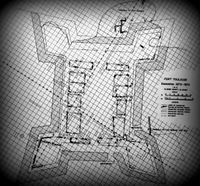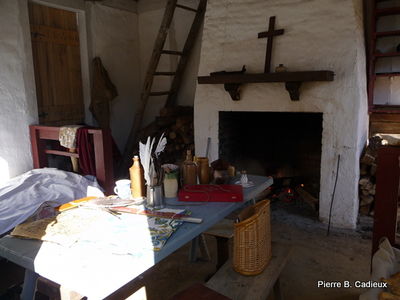Fort Toulouse (1)
|
Fort Toulouse (1) (1717-1763) - A French Colonial fort established in 1717 in present day Elmore County, Alabama, near Wetumpka, north of Montgomery. Named for the French Count of Toulouse Louis Alexandre de Bourbon, a son of king Louis XIV of France and president of the Conseil de la Marine, the fort was abandoned in 1763 when this part of Louisiana was ceded to British by treaty at the end of French & Indian War. It was called Poste aux Alibamons, Fort des Alibamons, Fort Toulouse des Alibamons, Alabama Fort, Alabama Post (and in English records of the time, "the fort at the Albamas"). Fort Jackson (1814-1817) – A military post established in 1814 on the same spot by Americans in the war against the Creeks and British.

The forts Lieutenant de LaTour built the first fort in 1717 with labor and material from the Alabamas on the narrow peninsula between Coosa and Tallapoosa rivers. It was a one foot oak log palisade fort with four bastions armed with 3 to 4 swivel guns measuring less than 150 feet between the bastions on a bluff along the shore of Coosa river, Fort Toulouse I. In 1725, they added a dry moat about seven and a half feet deep to repair and strengthen the fort. The stockade was enlarged and repaired in 1735. In 1748 the fort was in a dilapidated state and equipped with four carriage guns of four and six pounders and four swivel guns of one or two pounders. In 1751 a new wood fort with a log palisade was constructed 100 feet south of the old structure by sub-engineer François Saucier, Fort Toulouse II. Five buildings were erected inside: powder magazine, store, barracks and commandant house. 1814, Andrew Jackson and the militia constructed a new and larger fort, Fort Jackson, over the site of the old fort. The fort was garrisoned till 1817 and Governor Gibson tempted to establish a town there in 1820 without success.
History In 1911, the site is acquired by the State of Alabama. In 1920-1950, there was amateur archeological research on the site. 1971, the site became a park. 1972-1980 and 1984-1986 saw serious archeological investigations on the site of Fort Toulouse II and Fort Jackson, a part of Fort Toulouse I was discovered. The fort of 1751 was reconstructed following the archeological discoveries and can be visited today. In late July 1717, a wood fort was constructed at the confluence of Coosa and Tallapoosa near an Alabama village by the French to get the Alabamas, an agressive member of the Upper Creek confederation, in the French sphere of alliance after the Yamasee War (a rebellion of Native Americans against wrong behaviors of Carolina British traders), a strategic move for the control of North America by European Nations (French, Spanish and British) and for the security of French Mobile colony at a key position, and a protection for the Alabamas against the British. It was a military, trading and diplomatic fort built to avoid the threat from inland Native Americans on Louisiana towns and inhabitants, French and Native American allies. It was occupied by a small garrison of 20 to 50 regular soldiers and officers of Compagnie Franche de la Marine, some traders, and later a hundred settlers, several retired soldiers of the fort, often link with Alabamas. It was more a trading post to furnish Native Americans with desirable goods at the lowest price possible to attach them to the French and for diplomatic exchanges than a strong military fort against them. The second Fort Toulouse of 1751 was also constructed, supported and protected by their Alabamas neighbors because of their friendly ties until the end of the French and Indian War. It was situated close to the Lower Path, one of the main routes used by the British traders from Charleston to go to the Mississippi valley and the tribes, a valuable commerce. It was also close to some other main trade paths. The supply for the garrison and the trade came irregularly from Mobile by a flat bottom boat manned by 24 negro slaves, soldiers or Native Americans employed as oarsmen. The lack of supply and appalling conditions led to mutiny two third of the garrison in August 1721. Alabamas came to capture or kill the mutineers and to restore the authority of the officers. Part of the Creeks were pro-French, part were pro-British, so, to attach their allies, the French had to match their trade practices and prices to the British ones who continued to trade with the Creeks. For the Creeks, that situation assured them two different and concurrent sources of essential goods. Because of the skillful diplomacy of the French officers at Fort Toulouse, this frontier stayed quiet during all the occupation of the fort.  In 1749, flooding and erosion treated the fort too close to the bank of the river. The French must construct a new fort 100 feet south, in 1751 it cost 30 000 lives, half the budget for a year of construction and maintenance of all Louisiana fortifications. Between November 1763 and January 15, 1764, the fort was evacuated by the remnant of the French garrison under the command of LaNoue. British Colonel Robertson decided not to occupy the fort because it was too risky for a small garrison to stay in a hostile area. Alabamas wanted traders in their territory, not a garrison. Then the Alabamas moved their village of Taskigi to the site. In 1775, William Bartram visited the ruins of the French fort.  In the war of 1812-1814, the Creeks took the British side against the Americans. In 1813, a depot was constructed on the site for the campaign against the Creeks. After the decisive battle of Horseshoe Bend, in April 1814, General Andrew Jackson constructed a strong military fort at the site of late Fort Toulouse to keep an eye on the Creeks and to secure his campaign against the British in the South. The Fort Jackson was completed in July. On 9 Aug1814, Creeks signed the Treaty of Fort Jackson to end the war and ceded half of their territory. The garrison was maintained there until 1817 and settlers came, but the proposed town was moved elsewhere.
Current StatusMust See! A reconstructed and animated fort of 1751 can be visited in the Fort Toulouse – Fort Jackson State Historic Site, Elmore County, Alabama. You can see few buildings with costumed people acting as French garrison. There is a Creek house beside the reconstructed fort. Moat and ruins of Fort Jackson can be seen at the very site. A prehistoric Mississippian Indian Mound is seen east of the ruins.
See Also: Sources:
Links: Visited: 17 Apr 2016
| ||||||
